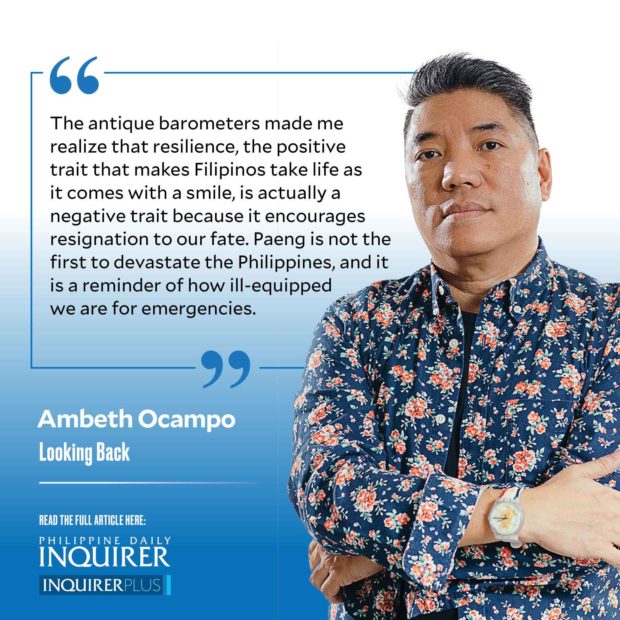Padre Faura’s barometer
Undas 2022 will be remembered for the death and destruction caused by Severe Tropical Storm “Paeng.”
Two years ago, I wrote about the famous barometer invented by Fr. Federico Faura (for whom the Ermita street is named) and asked why it went out of fashion. I would think that people who lived in a country visited by destructive typhoons each year should have barometers in their homes beside wall clocks. I guess online weather reports are more accurate, but then what about people who have no access to the internet? It was uncanny that I had just seen two Faura barometers displayed in the Museo Naval in Madrid last week when I heard news of the bad weather in the Philippines.
The antique barometer made me realize that resilience, the positive trait that makes Filipinos take life as it comes with a smile, is actually a negative trait because it encourages resignation to our fate. Paeng is not the first to devastate the Philippines, and it is a reminder of how ill-equipped we are for emergencies. We can’t just shrug our shoulders and promise to do better; the loss of property and human life should make people demand that things should not continue the way they are. A plane accident closed the Mactan-Cebu International Airport for more than a day, is that acceptable?
In 1865, before Pagasa and online weather apps, we had the Jesuit-run Manila Observatory as the Philippine weather bureau. For those without access to the data compiled by the observatory or its weather bulletins, Faura published a 14-page work, “Señales precursoras de temporal en el Archipiélago Filipino,” in 1882 to help lay people read the indications of bad weather.
If proof were needed to validate its use outside the Philippines, the captain of the steamer Haiphong sought Faura’s permission to translate “Señales” from the original Spanish into French for use in the company’s vessels plying Asian routes. In 1886, Faura presented the first aneroid barometer calibrated for use in the Philippines to the Sociedad Económica de Amigos del País (Economic Society of the Friends of the Country) accompanied by a 13-page pamphlet explaining its indicators. This device was an instant hit, and came to be known as the “Faura barometer” down to 1955 when it was still distributed by La Estrella del Norte (aka Levy Hermanos Inc.) in Manila.
The Faura barometers presently on display in the Museo Naval in Madrid have the Spanish face (an English version was made available later) that provide variables in weather (from good to bad) and, more importantly, if the “baguio” (storm) is far or close to the place where the barometer is read. It also warned users if the baguio was strong (intense) or destructive. People who have seen a Spanish Faura barometer usually ask me if baguio, our word for typhoon or storm, originated from the name of our summer capital. My usual reply is that I am neither Google nor Ernie Baron and need to research the answer.
The early Faura barometers were manufactured in London for use in the Philippines. These sold like hotcakes and even encouraged cheap knock-offs and fakes. Prewar homes used to have Faura barometers and even fisherfolk had access to one, so I wonder when and why these fell out of fashion. You will only find a Faura barometer on eBay or in antique shops today, but its continuing relevance shows not just its usefulness, but that Faura is an early example of open source technology. He did not patent his barometer, a decision that could have made himself, the Jesuits, or the Manila Observatory rich!
Obsolete Faura barometers used to be available from antique shops in Ermita, and I brought a few to Manila Observatory director Fr. Victor Badillo, SJ, to know if they were working or still accurate. The first test was the “katok method.” He knocked on the glass cover with his knuckles to see if the needles reacted to percussion. Those that did, we took on a ride up and down the observatory elevators. A friend who just had his Faura barometer reconditioned taught me a new way of testing: seal the device in a Ziploc bag with air, then squeeze the bag and the barometer needles will react.
After this column is published, I will not be able to find or afford a Faura barometer anymore, but if it makes people know of its historical and scientific value, that’s good enough for me.
Comments are welcome at aocampo@ateneo.edu





















